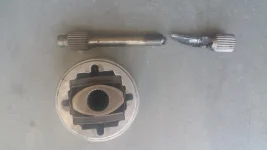The 53 series are wet liner engines. This means that coolant is in direct contact with the outside of the cylinder liners. This is also true of the 92 series. The coolant is prevented from leaking past the liners and into the air box (below) by 2 O-rings at the base of each liner. If the coolant chemistry is not properly maintained electrolysis will corrode grooves in the liners allowing coolant to bypass the O-rings into the air box. The liners and block are different types of iron/steel setting up the potential for electrolysis. Initially the leak will manifest as coolant dribbling from the air box drains. Eventually a catastrophic seal failure on one, or more, cylinders will occur. It sounds like this is what occurred with your engine.No coolant will appear in the crankcase oil. The coolant is drawn into the intake ports of the leaking cylinder and nearby cylinders. If this is what happened to your engine you will need an in-frame overhaul with new liners. Depending on engine hours, you should also replace the pistons and rings. It's possible that a cylinder head has been cracked also, but unlikely unless the fire-deck is thinned by corrosion during long periods of lay-up. Don't make the mistake of only replacing the leaking liners. If electrolysis occurred all liners will have suffered damage, but may not have leaked yet.The best way to determine if a massive coolant leak has occurred is to remove the air box covers and inspect the lower portion of each cylinder liner with a video probe or bore scope. The inside of the air box will be coated with nasty black oily gunk. If coolant is in there it will be beaded up and obvious. You will likely see cracks in the ligaments between the intake ports on the cylinders that injected a large quantity of coolant. The good news is that cylinder kits (liners, pistons, rings) are readily available for the 53 series. The not so good news is that cylinder heads for the 8V53 are rare if you should need one.I had this failure on my 6V53s several years ago. Send me a PM if you want to talk more about this.



